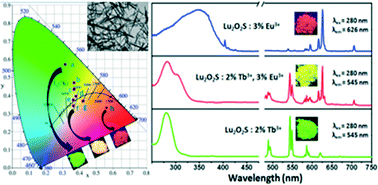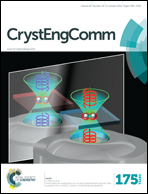Lu2O2S:Tb3+, Eu3+ nanorods: luminescence, energy transfer, and multicolour tuneable emission
Abstract
A series of Tb3+ and Eu3+ singly-doped and co-doped rod-like Lu2O2S phosphors have been synthesized via a facile hydrothermal method followed by a subsequent calcination process. The phosphors, with excellent dispersion and uniform rods, exhibit the characteristic Tb3+ or/and Eu3+ emissions with the strongest peaks located at 544 nm (green) and 626 nm (red), respectively. Moreover, the emission intensities of both Tb3+ and Eu3+ remarkably vary with increasing Eu3+ incorporation, and as a result, bright and tunable color emission can be realized in the single-phase Lu2O2S host by varying the ratio of Eu3+ to Tb3+ ions. In addition, the multicolor luminescence of Tb3+ and Eu3+ co-doped rod-like Lu2O2S phosphors can be readily achieved by changing the excitation wavelengths. The energy transfer from Tb3+ to Eu3+ ions in Lu2O2S was systematically investigated in detail. These results prove that the as-synthesized Lu2O2S nanorods are an excellent host for rare earth luminescence, and the Lu2O2S:Tb3+, Eu3+ nanorods with tunable multicolor luminescence properties may have potential applications in the fields of full-color displays, solid-state light and field emission displays.


 Please wait while we load your content...
Please wait while we load your content...